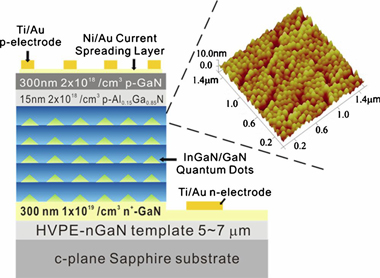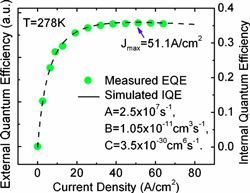
| Home | About Us | Contribute | Bookstore | Advertising | Subscribe for Free NOW! |
| News Archive | Features | Events | Recruitment | Directory |
News
13 July 2010
Self-organized quantum dots reduce green efficiency droop
Green light emitting diodes (LEDs) based on layers of self-assembled quantum dots (QDs) in indium gallium nitride (InGaN) have been produced at the University of Michigan’s Center for Nanoscale Photonics and Spintronics [Meng Zhang et al, Appl. Phys. Lett., vol97, p011103, 2010]. Among the characteristics that are seen are a reduced blue-shift at higher currents and a smaller ‘efficiency droop’ compared with traditional green LEDs.
Normally, green LEDs are produced from layers constituting single-quantum-well/double heterostructures (QW/DH) or multi-quantum-wells (MQWs) of InGaN material sandwiched between GaN or wider-bandgap InGaN barriers. One nasty feature of green LEDs is an efficiency droop that occurs at higher injection current density. Although efficiency droops are seen at shorter emission wavelengths, they are generally not as severe.
Various explanations have been advanced for this droop. One of the most popular is Auger recombination where, instead of recombining as light, electrons and holes transfer their energy to a third charge carrier. This process is more likely at higher injection currents.
Another drawback of InGaN layers sandwiched between GaN is that the lattice mismatch sets up large strains that create large piezoelectric polarization fields. These polarization fields tend to work against the recombination of the electrons and holes, reducing the light emission. Theory suggests that the use of QDs could reduce the problem of piezoelectric fields, and one might hope that increased light emission could result from their use.
The Michigan devices (Figure 1) were grown on GaN/sapphire substrates using plasma-assisted molecular beam epitaxy (PAMBE). The silicon-doped (n-type) substrates were produced using hydride vapor phase epitaxy (HVPE). The self-assembled QD layers had a dot density in the range 2–5x1010/cm2 in different samples. The dot base width and height ranges were 50–100nm and 3–4nm, respectively. Transmission electron microscopy gave a dislocation density in the surrounding GaN material of 109/cm2, giving an estimated dislocation-free environment for the radiative recombination of electrons and holes in the QDs of more than 95%.

Figure 1: InGaN/GaN quantum dot LED heterostructure grown on GaN-templated c-plane sapphire substrates. Inset: AFM image 1.5μm x 1.5μm of uncapped self-organized
In0.25Ga0.75N/GaN QDs.
The LEDs include an aluminum gallium nitride (AlGaN) electron-blocking layer (EBL) to avoid electron overshoot into the p-contact region, where they would recombine non-radiatively or at parasitic non-green frequencies.
Photoluminescence (PL) measurements on the LED epitaxial material suggest an internal quantum efficiency (IQE) value for the structure of 32% with a peak wavelength of 500nm (blue-green). The recombination lifetime, derived from time-resolved PL (TRPL) measurements, is given as 0.57ns. Combining this result with the IQE figure gives a radiative lifetime of 1.78ns and a non-radiative lifetime of 0.84ns. The researchers compare this with typical figures from traditional InGaN/GaN multi-quantum-well structures of about 380ns and 120ns, respectively. A shorter lifetime implies a higher recombination rate.
Electroluminescence (EL) measurements were carried out on an LED that emitted at the green wavelength of 524nm with injection currents between 20mA and 500mA. The LED temperature was controlled at 278K (~5°C).
As the current increases to 350mA there is a small blue-shift by 4.8nm, after which current the wavelength remains constant. This compares with blue-shifts of between 20nm and 30nm typically in MQW devices grown on c-plane sapphire. The QD blue-shift is comparable with the smaller values seen in more recent MQWs grown on non-polar m-plane bulk GaN substrates. The small blue-shift suggests a polarization electric field in the QDs of ~90kV/cm, compared with fields of ~2MV/cm in c-plane grown MQW LEDs.
The QD devices also showed less fall-off in efficiency at higher currents (‘efficiency droop’) beyond its peak value at 51.1A/cm2 current density, compared with traditional green LEDs (Figure 2). The measured values are compared with a model for the IQE (Equations 1 and 2) including unwanted Shockley-Read-Hall (A) and Auger (C) non-radiative recombination processes and the wanted radiative process (B). The Shockley–Read–Hall process is most significant at lower currents, but the Auger process only becomes important at higher current densities.
 Figure 2: Measured EQE in arbitrary units peaking at 51.1A/cm2. Calculated IQE, based on the ABC recombination model (Equations 1 and 2) and shown by the dashed curve, is in good agreement with the EQE. The recombination constants assume the recombination thickness of each dot layer to be 3nm.
Figure 2: Measured EQE in arbitrary units peaking at 51.1A/cm2. Calculated IQE, based on the ABC recombination model (Equations 1 and 2) and shown by the dashed curve, is in good agreement with the EQE. The recombination constants assume the recombination thickness of each dot layer to be 3nm.
Equation 1. IQE relation to recombination constants and carrier density:
![]()
Equation 2. Injection current density relation to carrier density:
![]()
The value of ‘Auger’ recombination (i.e. the constant C) in 407nm near-ultraviolet LEDs has previously been found by Michigan to be 1.5x10−30cm6/s. The value for the coefficient is believed to be enhanced for green light emission by a resonance effect to give an enhanced ‘Auger-like’ behavior. Hence the Auger coefficients for QWs and QDs may well be similar in value. The route to reducing this effect would then be creating higher rates of light emission from lower carrier densities.
The researchers also believe that tunnel injection might be a useful way of pushing suitable carriers into the QDs. Such techniques have been used to reduce hot-carrier effects in laser and LEDs, thus improving performance.
See related item:
InGaN LED spillover and efficiency droop
![]() Search: Green LEDs MQWs InGaN Green LED droop
Search: Green LEDs MQWs InGaN Green LED droop
Visit: http://link.aip.org
The author Mike Cooke is a freelance technology journalist who has worked in the semiconductor and advanced technology sectors since 1997.